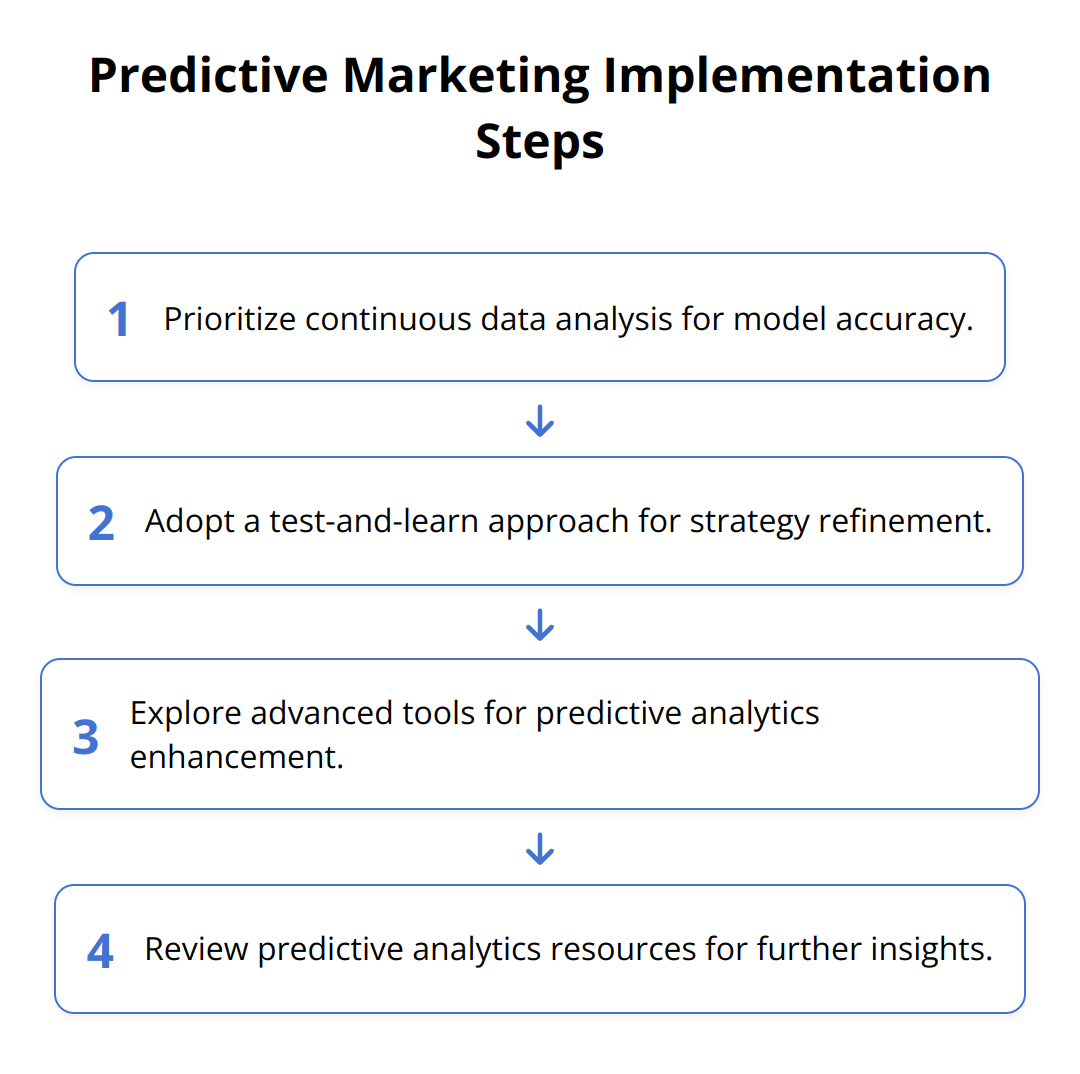Predictive marketing is revolutionizing the way B2B companies target their markets, transforming data into actionable insights. We at Emplibot believe that understanding this approach can significantly impact your business strategies. It leverages advanced analytics to anticipate customer behaviors and preferences, setting a new standard for marketing efficiency. This guide will navigate through the essentials of B2B predictive marketing, highlighting its unique benefits and practical applications.
Contents
ToggleWhat is B2B Predictive Marketing?
B2B predictive marketing is a game-changer for businesses looking to streamline their marketing strategies. Unlike traditional approaches, it does not solely rely on historical performance data. Instead, it uses machine learning and data analytics to predict future customer behaviors and preferences. This allows businesses to craft personalized, data-driven campaigns that resonate with their target audience.
Traditional vs Predictive Marketing
The main difference between traditional marketing and B2B predictive marketing lies in foresight and personalization. Traditional methods focus on broad strategies that aim to cater to general audiences. This often results in a one-size-fits-all approach, which lacks the precision needed in today’s highly competitive market.
On the other hand, predictive marketing harnesses the power of data analysis to foresee customer needs and tailor marketing efforts accordingly. This approach not only increases engagement rates but also improves overall return on investment (ROI).
Why It Matters Now
In the current business landscape, where competition is stiff and customer expectations are high, predictive marketing stands out as a vital strategy. Here’s why:
-
Data Driven: With an increasing amount of data available, businesses can leverage predictive analytics to gain a competitive edge.
-
Efficiency: It helps optimize marketing budgets by focusing efforts on the most promising leads and opportunities.
-
Personalization: Predictive marketing enables hyper-personalization, which is key to customer satisfaction and loyalty.
Businesses that have adopted predictive marketing have seen significant improvements in customer engagement and sales conversions. For instance, companies using data to personalize emails have witnessed a 760% increase in email revenue (predictive analytics for B2B marketing).

Practical Tips for Implementation
To start with B2B predictive marketing, follow these steps:
-
Gather and Analyze Data: Collect as much data as possible from various sources (CRM, social media, etc.) and analyze it for patterns.
-
Choose the Right Tools: Use predictive analytics tools that are suited for B2B marketing. Tools like Clearbit and Domo can be instrumental.
-
Focus on Quality Data: Ensure your data is clean and accurate. This is the foundation of effective predictive modeling.
Looking Ahead
As we glance into the future, it’s clear that the role of predictive marketing in B2B strategies will only grow stronger. Businesses that embrace this approach sooner will likely outpace their competitors in terms of customer engagement and sales. Keep an eye on emerging trends and tools in predictive analytics to stay ahead in the game.
How Does B2B Predictive Marketing Work?
Understanding the mechanics of B2B predictive marketing is pivotal for businesses aiming to refine their outreach and bolster campaign effectiveness. Rather than a shot in the dark, predictive marketing is about making educated predictions where data is the guiding light.
The Foundation: Data Collection and Quality
At its core, predictive marketing relies on a robust framework of data collection and analysis. A diverse range of data sources, including customer relationship management (CRM) systems, social media interaction, website analytics, and even external market conditions, are analyzed to uncover patterns that might not be immediately visible.
One cannot overstate the importance of data quality. Incorrect or outdated information can lead directly to misguided predictions and wasted marketing efforts. A practice as simple as regular database maintenance can have profound impacts on the accuracy of your predictive models.
Building Predictive Models
Predictive modeling stands as the pillar of predictive marketing. By employing machine learning algorithms, businesses can sift through vast amounts of data to identify probable future outcomes based on past behaviors. These models are not static; they evolve. Continuous refinement and testing against real-world outcomes are essential to increase their predictive accuracy.
Key steps include defining clear objectives (e.g., identifying potential high-value leads, predicting customer churn) and choosing the right model based on the task at hand. Common techniques such as regression analysis, clustering, and decision trees help in predicting customer behaviors and trends.
Execution: Turning Predictions into Action
The true power of predictive marketing is realized in the execution phase. Predictive analytics allows businesses to tailor their campaigns to meet the specific needs of segments within their market. This could mean developing personalized email campaigns that are sent out to prospects who are predicted to be at the peak of their purchase readiness or adjusting product recommendations for existing customers based on their predicted future interests.
Real-time data feeds keep predictive models current, enabling marketers to adjust their strategies on the fly. For example, a sudden change in online behavior patterns might indicate emerging trends that marketers can capitalize on quickly.

Tips for Effective Predictive Marketing:
-
Ensure data integration from multiple sources for a holistic view.
-
Focus on creating a cycle of continuous improvement for predictive models.
-
Personalize content and outreach strategies based on predictive insights.
-
Measure the effectiveness of predictive marketing efforts and continuously refine based on outcomes.
Predictive marketing is more than just a methodology; it’s a dynamic approach that requires attention, adaptation, and continuous learning. By committing to the practices outlined above, businesses can position themselves to better predict customer needs and craft marketing strategies that are not only efficient but also highly relevant and engaging.
For insights into crafting effective campaigns based on predictive analytics, consider exploring resources such as email marketing automation strategies. Through a combination of predictive analytics and automated execution, businesses can achieve unparalleled engagement and conversion rates.
Boosting B2B Success with Predictive Marketing
The leap into predictive marketing represents not just a shift in marketing tactics but a comprehensive overhaul of how B2B companies approach the market. Focusing on enhanced lead scoring, deeper customer insights, and a significant uptick in sales efficiency transforms predictive marketing from an option to an operational necessity. Here’s how businesses stand to gain by integrating predictive models into their marketing strategies.
Streamlining Lead Management
Predictive marketing refines the process of lead scoring and qualification. By analyzing historical data, companies can assign a predictive score to leads, indicating their likelihood to convert. This method surpasses traditional lead scoring by taking into account a multitude of factors beyond simple demographic information, including behavior patterns and engagement levels. The result? Marketing and sales teams can prioritize their efforts more effectively, concentrating on leads with the highest conversion potential. For instance, sales conversions can increase when teams focus on leads characterized by specific engagement patterns identified through predictive analytics.

Unlocking Customer Insights
At the heart of any successful marketing strategy lies a deep understanding of customer needs and preferences. Predictive marketing elevates this understanding by leveraging data to uncover not just who your customers are but also their future needs, potential objections, and even preferred channels of communication. This granular view into the customer psyche enables unprecedented levels of personalization, directly impacting customer satisfaction and loyalty. Incorporating predictive analytics into your strategy can lead to a more nuanced approach to customer segmentation, crafting messages that resonate on an individual level.
Driving Revenue Growth
Perhaps the most compelling argument for B2B predictive marketing is its direct impact on ROI and sales efficiency. By aligning marketing efforts with predictive insights, businesses can achieve higher engagement rates, more meaningful interactions, and ultimately, a better bottom line. Predictive marketing allows for more precise targeting and resource allocation, ensuring that marketing spend is optimized for the highest return. Moreover, the ability to forecast sales trends and customer needs increases operational efficiency, reducing waste and expediting the sales cycle.

Practical Actions for Implementation
-
Prioritize continuous data analysis to keep your predictive models accurate.
-
Adopt a test-and-learn approach, continuously refining strategies based on real-world results.
-
Explore tools and technologies that enhance predictive analytics capabilities. For insights into pertinent tools, reviewing predictive analytics marketing can be beneficial.
In integrating these methodologies, companies not only anticipate market trends but position themselves as leaders of the pack, setting the pace rather than trying to keep up. The ongoing evolution of predictive marketing promises even greater strides in the effectiveness of B2B marketing strategies, cementing its status as an indispensable asset for future-focused businesses.
Wrapping Up
B2B predictive marketing is not just a trend; it’s a transformational approach that reshapes how businesses engage with their markets. By blending sophisticated data analysis with machine learning, businesses can forecast customer behaviors, refine their marketing strategies, and tailor communications with unmatched precision. The advantages, ranging from increased efficiency and ROI to deep customer insights and personalized marketing, underscore the strategic value predictive marketing adds to B2B operations.

Key takeaways include the ability to make informed predictions about customer needs, leading to more engaging and successful marketing campaigns. The power of predictive marketing to optimize lead management and enhance customer loyalty is undeniable. With personalization at its core, this approach ensures that every marketing effort is not only seen but resonates with the intended audience, driving meaningful engagement and, ultimately, sales.
Businesses ready to leverage these benefits and steer towards remarkable growth should consider adopting predictive marketing practices. The journey towards predictive marketing mastery involves continuous learning, adaptation, and the right technological support. Tools and platforms that offer deep insights and analytics capabilities are indispensable in this journey. For those looking to excel in content creation and SEO, Emplibot emerges as a powerful ally, providing businesses with an automated solution for publishing SEO-friendly articles, complete with keyword research and internal linking, directly to their WordPress sites.
Now is the moment for businesses to embrace predictive marketing strategies, setting themselves apart in a competitive landscape and paving the way for unprecedented success. With the right approaches, tools, and mindset, the future of B2B marketing is not just predicted; it’s being created today. For further insights and strategies on predictive analytics in marketing, explore our comprehensive guide on predictive analytics marketing beginners guide.
Predictive marketing is more than a tool; it’s a strategic asset. We strongly believe businesses that adopt these practices will not only survive but thrive in the ever-evolving B2B landscape.











